Comprehensive Report: Total Quality Management in Mechanical Projects
VerifiedAdded on 2021/06/17
|10
|2228
|66
Report
AI Summary
This report provides a comprehensive overview of Total Quality Management (TQM) within the context of mechanical engineering projects. It begins by defining TQM and highlighting its importance in ensuring project success, emphasizing the need for effective quality management to meet stakeholder requirements. The report then delves into the core components and phases of TQM, including planning, quality checking, and cross-functional collaboration, while also detailing various tools and techniques such as cause-and-effect diagrams and control charts. It explores the advantages of TQM, such as cost reduction and improved customer satisfaction, while also acknowledging challenges like leadership and innovation. The conclusion emphasizes the significance of TQM in maintaining high standards throughout the project lifecycle and suggests regular audits and adaptability as key practices for effective implementation. The report references twelve scholarly papers to support its findings.
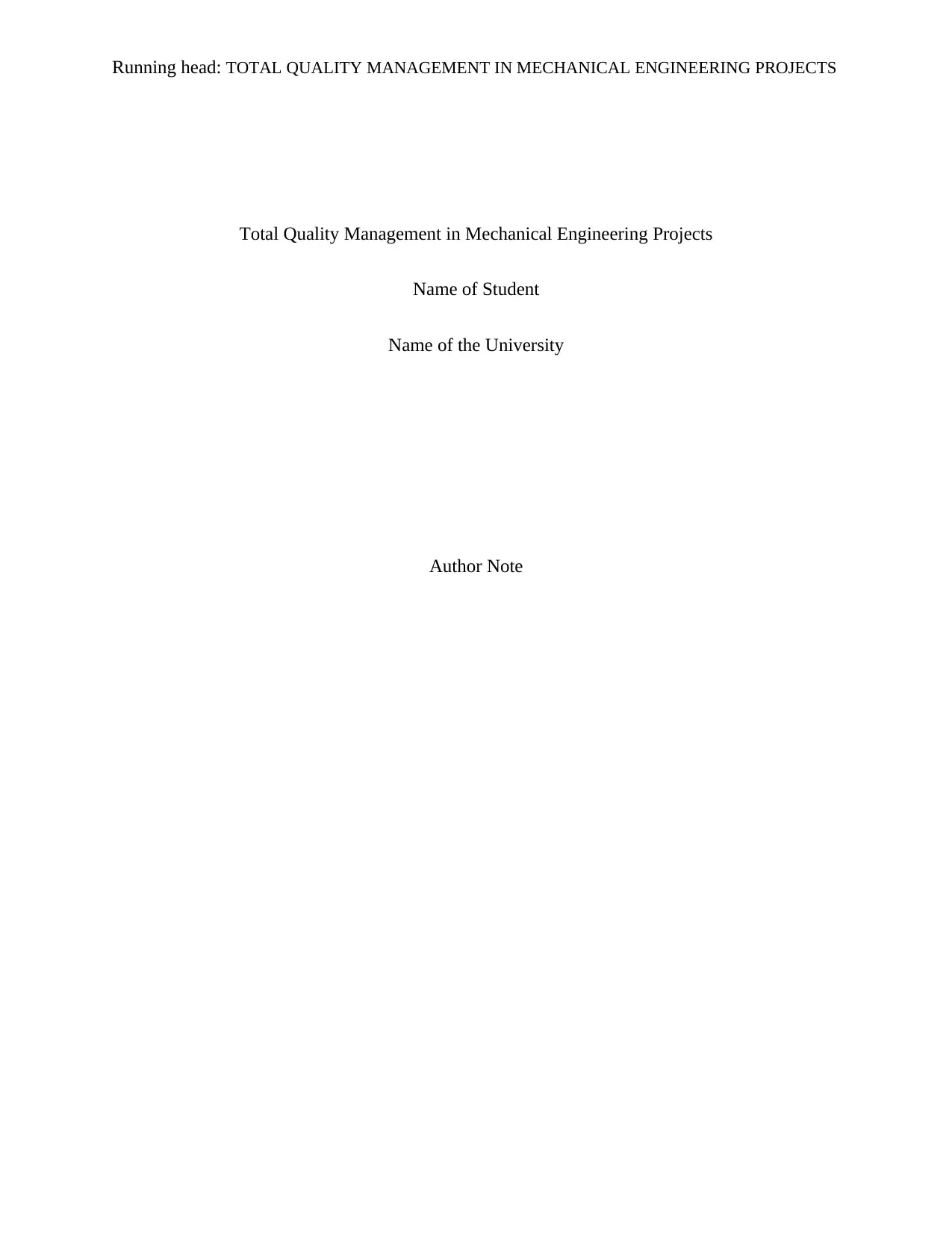
Running head: TOTAL QUALITY MANAGEMENT IN MECHANICAL ENGINEERING PROJECTS
Total Quality Management in Mechanical Engineering Projects
Name of Student
Name of the University
Author Note
Total Quality Management in Mechanical Engineering Projects
Name of Student
Name of the University
Author Note
Paraphrase This Document
Need a fresh take? Get an instant paraphrase of this document with our AI Paraphraser
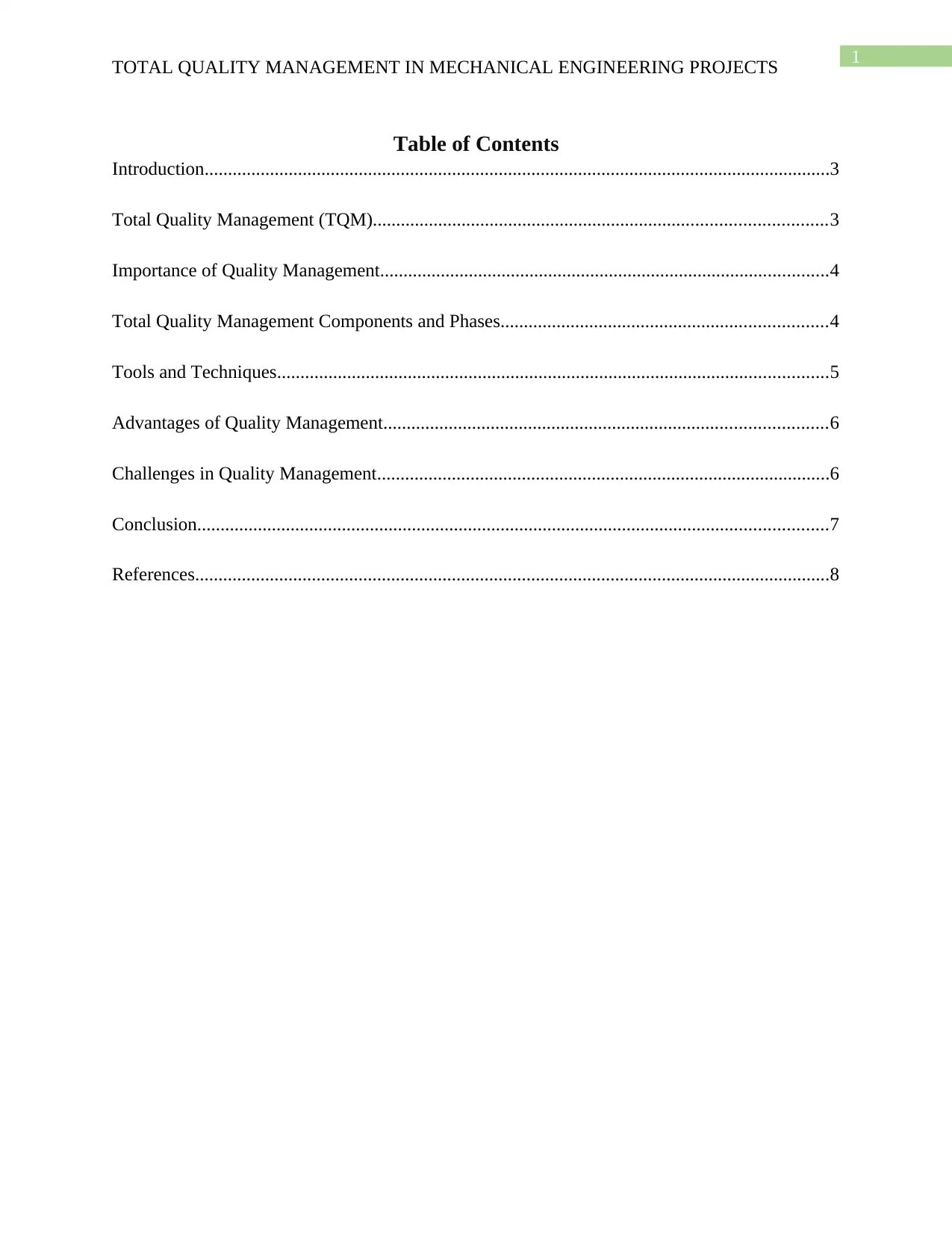
1
TOTAL QUALITY MANAGEMENT IN MECHANICAL ENGINEERING PROJECTS
Table of Contents
Introduction......................................................................................................................................3
Total Quality Management (TQM).................................................................................................3
Importance of Quality Management................................................................................................4
Total Quality Management Components and Phases......................................................................4
Tools and Techniques......................................................................................................................5
Advantages of Quality Management...............................................................................................6
Challenges in Quality Management.................................................................................................6
Conclusion.......................................................................................................................................7
References........................................................................................................................................8
TOTAL QUALITY MANAGEMENT IN MECHANICAL ENGINEERING PROJECTS
Table of Contents
Introduction......................................................................................................................................3
Total Quality Management (TQM).................................................................................................3
Importance of Quality Management................................................................................................4
Total Quality Management Components and Phases......................................................................4
Tools and Techniques......................................................................................................................5
Advantages of Quality Management...............................................................................................6
Challenges in Quality Management.................................................................................................6
Conclusion.......................................................................................................................................7
References........................................................................................................................................8
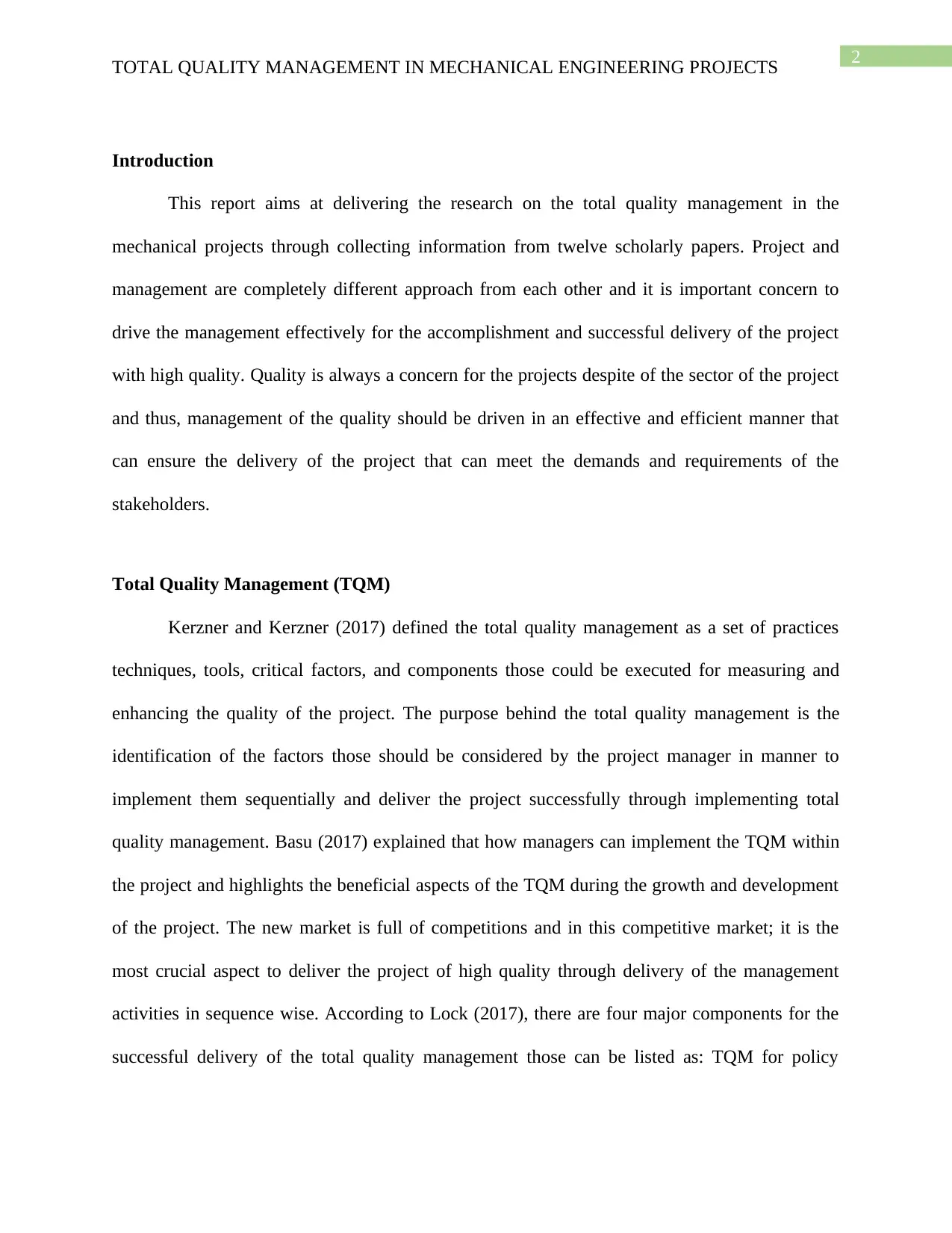
2
TOTAL QUALITY MANAGEMENT IN MECHANICAL ENGINEERING PROJECTS
Introduction
This report aims at delivering the research on the total quality management in the
mechanical projects through collecting information from twelve scholarly papers. Project and
management are completely different approach from each other and it is important concern to
drive the management effectively for the accomplishment and successful delivery of the project
with high quality. Quality is always a concern for the projects despite of the sector of the project
and thus, management of the quality should be driven in an effective and efficient manner that
can ensure the delivery of the project that can meet the demands and requirements of the
stakeholders.
Total Quality Management (TQM)
Kerzner and Kerzner (2017) defined the total quality management as a set of practices
techniques, tools, critical factors, and components those could be executed for measuring and
enhancing the quality of the project. The purpose behind the total quality management is the
identification of the factors those should be considered by the project manager in manner to
implement them sequentially and deliver the project successfully through implementing total
quality management. Basu (2017) explained that how managers can implement the TQM within
the project and highlights the beneficial aspects of the TQM during the growth and development
of the project. The new market is full of competitions and in this competitive market; it is the
most crucial aspect to deliver the project of high quality through delivery of the management
activities in sequence wise. According to Lock (2017), there are four major components for the
successful delivery of the total quality management those can be listed as: TQM for policy
TOTAL QUALITY MANAGEMENT IN MECHANICAL ENGINEERING PROJECTS
Introduction
This report aims at delivering the research on the total quality management in the
mechanical projects through collecting information from twelve scholarly papers. Project and
management are completely different approach from each other and it is important concern to
drive the management effectively for the accomplishment and successful delivery of the project
with high quality. Quality is always a concern for the projects despite of the sector of the project
and thus, management of the quality should be driven in an effective and efficient manner that
can ensure the delivery of the project that can meet the demands and requirements of the
stakeholders.
Total Quality Management (TQM)
Kerzner and Kerzner (2017) defined the total quality management as a set of practices
techniques, tools, critical factors, and components those could be executed for measuring and
enhancing the quality of the project. The purpose behind the total quality management is the
identification of the factors those should be considered by the project manager in manner to
implement them sequentially and deliver the project successfully through implementing total
quality management. Basu (2017) explained that how managers can implement the TQM within
the project and highlights the beneficial aspects of the TQM during the growth and development
of the project. The new market is full of competitions and in this competitive market; it is the
most crucial aspect to deliver the project of high quality through delivery of the management
activities in sequence wise. According to Lock (2017), there are four major components for the
successful delivery of the total quality management those can be listed as: TQM for policy
⊘ This is a preview!⊘
Do you want full access?
Subscribe today to unlock all pages.

Trusted by 1+ million students worldwide
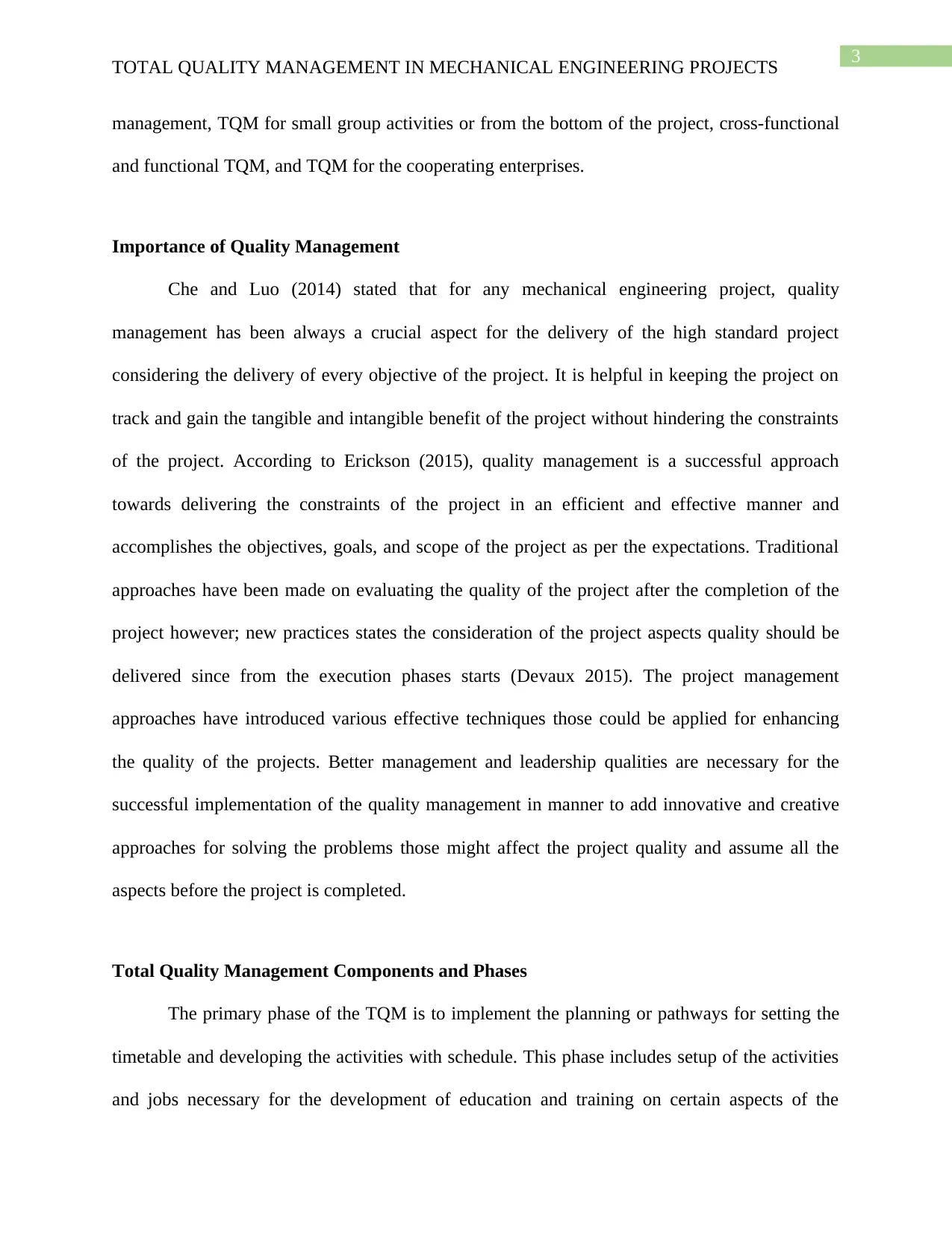
3
TOTAL QUALITY MANAGEMENT IN MECHANICAL ENGINEERING PROJECTS
management, TQM for small group activities or from the bottom of the project, cross-functional
and functional TQM, and TQM for the cooperating enterprises.
Importance of Quality Management
Che and Luo (2014) stated that for any mechanical engineering project, quality
management has been always a crucial aspect for the delivery of the high standard project
considering the delivery of every objective of the project. It is helpful in keeping the project on
track and gain the tangible and intangible benefit of the project without hindering the constraints
of the project. According to Erickson (2015), quality management is a successful approach
towards delivering the constraints of the project in an efficient and effective manner and
accomplishes the objectives, goals, and scope of the project as per the expectations. Traditional
approaches have been made on evaluating the quality of the project after the completion of the
project however; new practices states the consideration of the project aspects quality should be
delivered since from the execution phases starts (Devaux 2015). The project management
approaches have introduced various effective techniques those could be applied for enhancing
the quality of the projects. Better management and leadership qualities are necessary for the
successful implementation of the quality management in manner to add innovative and creative
approaches for solving the problems those might affect the project quality and assume all the
aspects before the project is completed.
Total Quality Management Components and Phases
The primary phase of the TQM is to implement the planning or pathways for setting the
timetable and developing the activities with schedule. This phase includes setup of the activities
and jobs necessary for the development of education and training on certain aspects of the
TOTAL QUALITY MANAGEMENT IN MECHANICAL ENGINEERING PROJECTS
management, TQM for small group activities or from the bottom of the project, cross-functional
and functional TQM, and TQM for the cooperating enterprises.
Importance of Quality Management
Che and Luo (2014) stated that for any mechanical engineering project, quality
management has been always a crucial aspect for the delivery of the high standard project
considering the delivery of every objective of the project. It is helpful in keeping the project on
track and gain the tangible and intangible benefit of the project without hindering the constraints
of the project. According to Erickson (2015), quality management is a successful approach
towards delivering the constraints of the project in an efficient and effective manner and
accomplishes the objectives, goals, and scope of the project as per the expectations. Traditional
approaches have been made on evaluating the quality of the project after the completion of the
project however; new practices states the consideration of the project aspects quality should be
delivered since from the execution phases starts (Devaux 2015). The project management
approaches have introduced various effective techniques those could be applied for enhancing
the quality of the projects. Better management and leadership qualities are necessary for the
successful implementation of the quality management in manner to add innovative and creative
approaches for solving the problems those might affect the project quality and assume all the
aspects before the project is completed.
Total Quality Management Components and Phases
The primary phase of the TQM is to implement the planning or pathways for setting the
timetable and developing the activities with schedule. This phase includes setup of the activities
and jobs necessary for the development of education and training on certain aspects of the
Paraphrase This Document
Need a fresh take? Get an instant paraphrase of this document with our AI Paraphraser
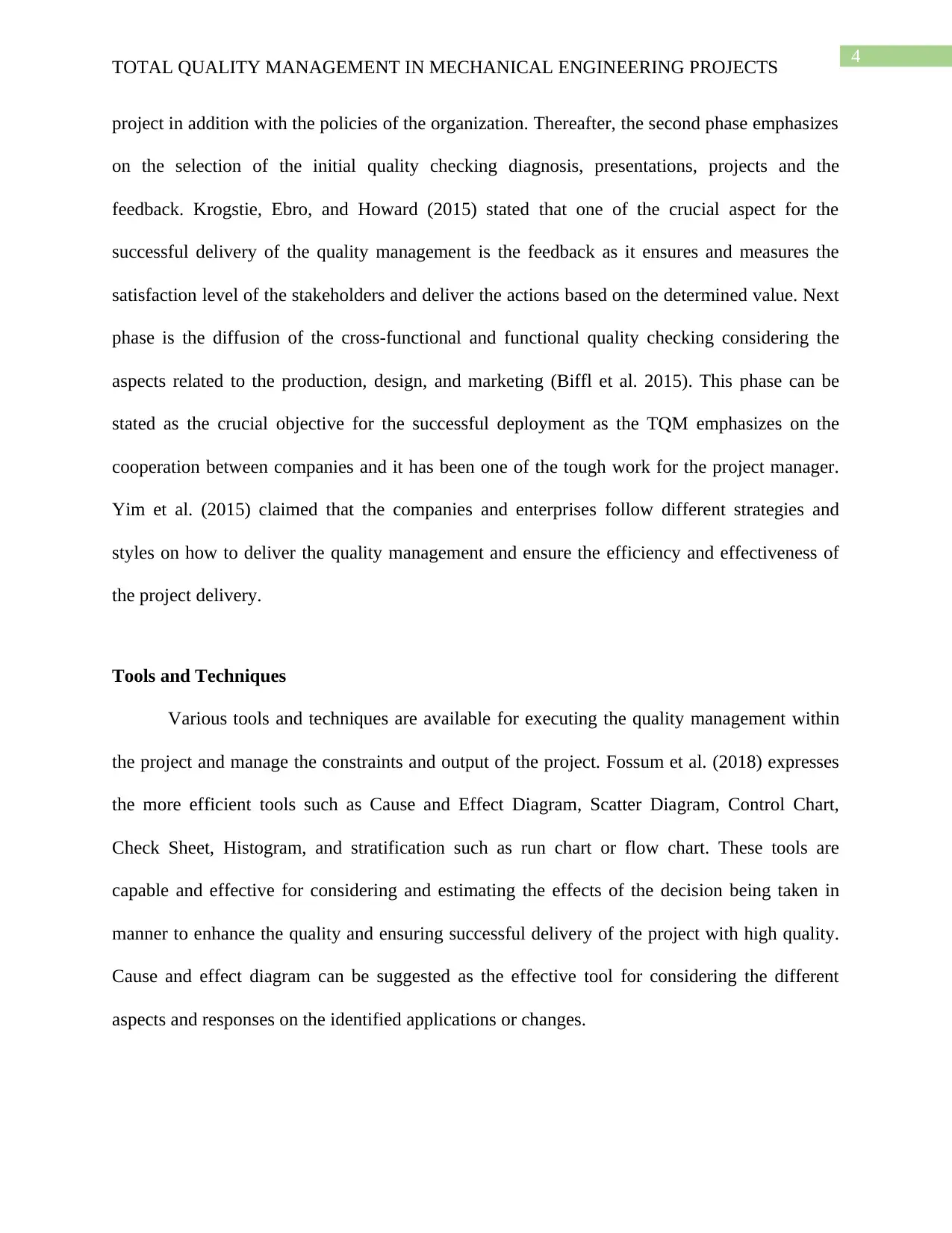
4
TOTAL QUALITY MANAGEMENT IN MECHANICAL ENGINEERING PROJECTS
project in addition with the policies of the organization. Thereafter, the second phase emphasizes
on the selection of the initial quality checking diagnosis, presentations, projects and the
feedback. Krogstie, Ebro, and Howard (2015) stated that one of the crucial aspect for the
successful delivery of the quality management is the feedback as it ensures and measures the
satisfaction level of the stakeholders and deliver the actions based on the determined value. Next
phase is the diffusion of the cross-functional and functional quality checking considering the
aspects related to the production, design, and marketing (Biffl et al. 2015). This phase can be
stated as the crucial objective for the successful deployment as the TQM emphasizes on the
cooperation between companies and it has been one of the tough work for the project manager.
Yim et al. (2015) claimed that the companies and enterprises follow different strategies and
styles on how to deliver the quality management and ensure the efficiency and effectiveness of
the project delivery.
Tools and Techniques
Various tools and techniques are available for executing the quality management within
the project and manage the constraints and output of the project. Fossum et al. (2018) expresses
the more efficient tools such as Cause and Effect Diagram, Scatter Diagram, Control Chart,
Check Sheet, Histogram, and stratification such as run chart or flow chart. These tools are
capable and effective for considering and estimating the effects of the decision being taken in
manner to enhance the quality and ensuring successful delivery of the project with high quality.
Cause and effect diagram can be suggested as the effective tool for considering the different
aspects and responses on the identified applications or changes.
TOTAL QUALITY MANAGEMENT IN MECHANICAL ENGINEERING PROJECTS
project in addition with the policies of the organization. Thereafter, the second phase emphasizes
on the selection of the initial quality checking diagnosis, presentations, projects and the
feedback. Krogstie, Ebro, and Howard (2015) stated that one of the crucial aspect for the
successful delivery of the quality management is the feedback as it ensures and measures the
satisfaction level of the stakeholders and deliver the actions based on the determined value. Next
phase is the diffusion of the cross-functional and functional quality checking considering the
aspects related to the production, design, and marketing (Biffl et al. 2015). This phase can be
stated as the crucial objective for the successful deployment as the TQM emphasizes on the
cooperation between companies and it has been one of the tough work for the project manager.
Yim et al. (2015) claimed that the companies and enterprises follow different strategies and
styles on how to deliver the quality management and ensure the efficiency and effectiveness of
the project delivery.
Tools and Techniques
Various tools and techniques are available for executing the quality management within
the project and manage the constraints and output of the project. Fossum et al. (2018) expresses
the more efficient tools such as Cause and Effect Diagram, Scatter Diagram, Control Chart,
Check Sheet, Histogram, and stratification such as run chart or flow chart. These tools are
capable and effective for considering and estimating the effects of the decision being taken in
manner to enhance the quality and ensuring successful delivery of the project with high quality.
Cause and effect diagram can be suggested as the effective tool for considering the different
aspects and responses on the identified applications or changes.
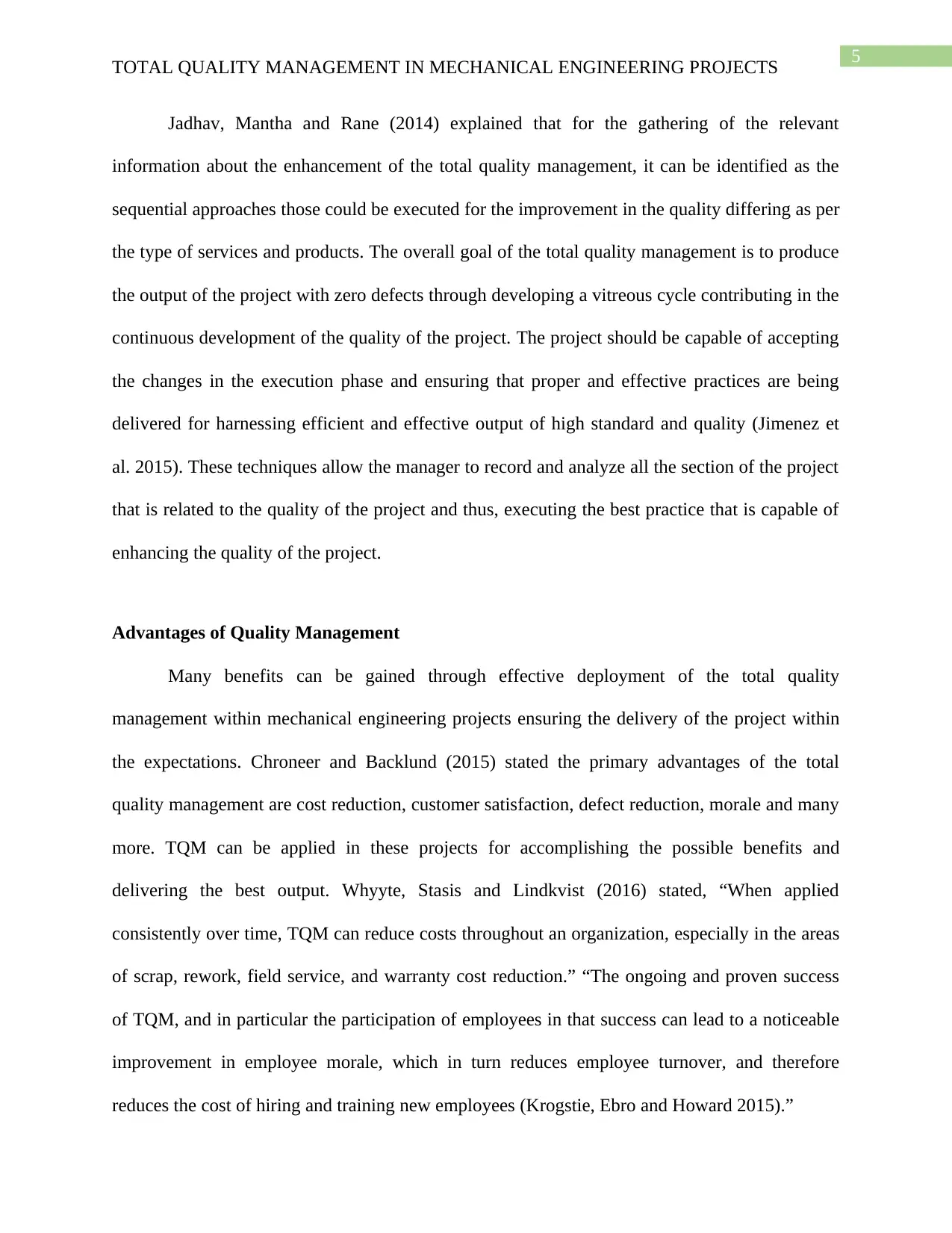
5
TOTAL QUALITY MANAGEMENT IN MECHANICAL ENGINEERING PROJECTS
Jadhav, Mantha and Rane (2014) explained that for the gathering of the relevant
information about the enhancement of the total quality management, it can be identified as the
sequential approaches those could be executed for the improvement in the quality differing as per
the type of services and products. The overall goal of the total quality management is to produce
the output of the project with zero defects through developing a vitreous cycle contributing in the
continuous development of the quality of the project. The project should be capable of accepting
the changes in the execution phase and ensuring that proper and effective practices are being
delivered for harnessing efficient and effective output of high standard and quality (Jimenez et
al. 2015). These techniques allow the manager to record and analyze all the section of the project
that is related to the quality of the project and thus, executing the best practice that is capable of
enhancing the quality of the project.
Advantages of Quality Management
Many benefits can be gained through effective deployment of the total quality
management within mechanical engineering projects ensuring the delivery of the project within
the expectations. Chroneer and Backlund (2015) stated the primary advantages of the total
quality management are cost reduction, customer satisfaction, defect reduction, morale and many
more. TQM can be applied in these projects for accomplishing the possible benefits and
delivering the best output. Whyyte, Stasis and Lindkvist (2016) stated, “When applied
consistently over time, TQM can reduce costs throughout an organization, especially in the areas
of scrap, rework, field service, and warranty cost reduction.” “The ongoing and proven success
of TQM, and in particular the participation of employees in that success can lead to a noticeable
improvement in employee morale, which in turn reduces employee turnover, and therefore
reduces the cost of hiring and training new employees (Krogstie, Ebro and Howard 2015).”
TOTAL QUALITY MANAGEMENT IN MECHANICAL ENGINEERING PROJECTS
Jadhav, Mantha and Rane (2014) explained that for the gathering of the relevant
information about the enhancement of the total quality management, it can be identified as the
sequential approaches those could be executed for the improvement in the quality differing as per
the type of services and products. The overall goal of the total quality management is to produce
the output of the project with zero defects through developing a vitreous cycle contributing in the
continuous development of the quality of the project. The project should be capable of accepting
the changes in the execution phase and ensuring that proper and effective practices are being
delivered for harnessing efficient and effective output of high standard and quality (Jimenez et
al. 2015). These techniques allow the manager to record and analyze all the section of the project
that is related to the quality of the project and thus, executing the best practice that is capable of
enhancing the quality of the project.
Advantages of Quality Management
Many benefits can be gained through effective deployment of the total quality
management within mechanical engineering projects ensuring the delivery of the project within
the expectations. Chroneer and Backlund (2015) stated the primary advantages of the total
quality management are cost reduction, customer satisfaction, defect reduction, morale and many
more. TQM can be applied in these projects for accomplishing the possible benefits and
delivering the best output. Whyyte, Stasis and Lindkvist (2016) stated, “When applied
consistently over time, TQM can reduce costs throughout an organization, especially in the areas
of scrap, rework, field service, and warranty cost reduction.” “The ongoing and proven success
of TQM, and in particular the participation of employees in that success can lead to a noticeable
improvement in employee morale, which in turn reduces employee turnover, and therefore
reduces the cost of hiring and training new employees (Krogstie, Ebro and Howard 2015).”
⊘ This is a preview!⊘
Do you want full access?
Subscribe today to unlock all pages.

Trusted by 1+ million students worldwide
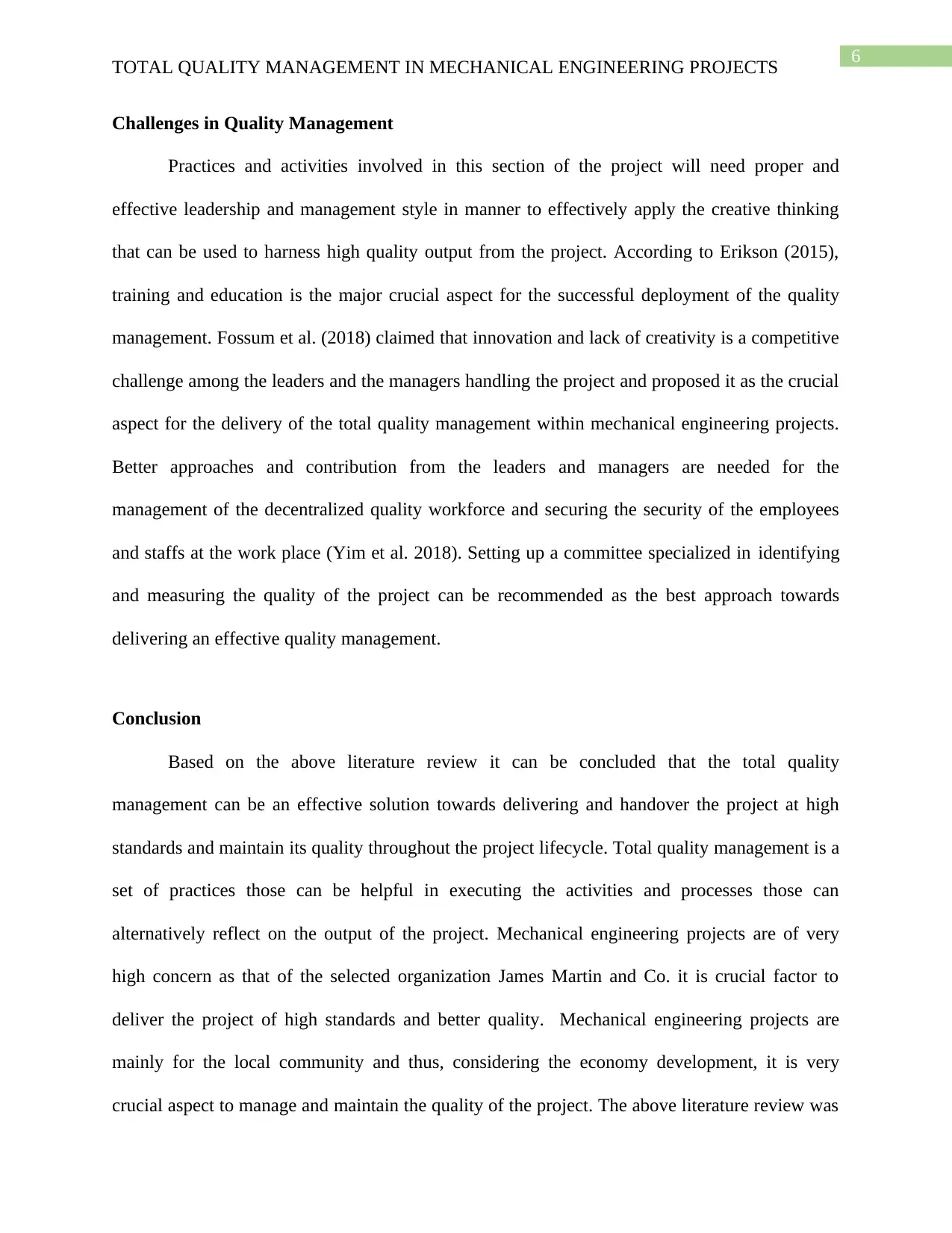
6
TOTAL QUALITY MANAGEMENT IN MECHANICAL ENGINEERING PROJECTS
Challenges in Quality Management
Practices and activities involved in this section of the project will need proper and
effective leadership and management style in manner to effectively apply the creative thinking
that can be used to harness high quality output from the project. According to Erikson (2015),
training and education is the major crucial aspect for the successful deployment of the quality
management. Fossum et al. (2018) claimed that innovation and lack of creativity is a competitive
challenge among the leaders and the managers handling the project and proposed it as the crucial
aspect for the delivery of the total quality management within mechanical engineering projects.
Better approaches and contribution from the leaders and managers are needed for the
management of the decentralized quality workforce and securing the security of the employees
and staffs at the work place (Yim et al. 2018). Setting up a committee specialized in identifying
and measuring the quality of the project can be recommended as the best approach towards
delivering an effective quality management.
Conclusion
Based on the above literature review it can be concluded that the total quality
management can be an effective solution towards delivering and handover the project at high
standards and maintain its quality throughout the project lifecycle. Total quality management is a
set of practices those can be helpful in executing the activities and processes those can
alternatively reflect on the output of the project. Mechanical engineering projects are of very
high concern as that of the selected organization James Martin and Co. it is crucial factor to
deliver the project of high standards and better quality. Mechanical engineering projects are
mainly for the local community and thus, considering the economy development, it is very
crucial aspect to manage and maintain the quality of the project. The above literature review was
TOTAL QUALITY MANAGEMENT IN MECHANICAL ENGINEERING PROJECTS
Challenges in Quality Management
Practices and activities involved in this section of the project will need proper and
effective leadership and management style in manner to effectively apply the creative thinking
that can be used to harness high quality output from the project. According to Erikson (2015),
training and education is the major crucial aspect for the successful deployment of the quality
management. Fossum et al. (2018) claimed that innovation and lack of creativity is a competitive
challenge among the leaders and the managers handling the project and proposed it as the crucial
aspect for the delivery of the total quality management within mechanical engineering projects.
Better approaches and contribution from the leaders and managers are needed for the
management of the decentralized quality workforce and securing the security of the employees
and staffs at the work place (Yim et al. 2018). Setting up a committee specialized in identifying
and measuring the quality of the project can be recommended as the best approach towards
delivering an effective quality management.
Conclusion
Based on the above literature review it can be concluded that the total quality
management can be an effective solution towards delivering and handover the project at high
standards and maintain its quality throughout the project lifecycle. Total quality management is a
set of practices those can be helpful in executing the activities and processes those can
alternatively reflect on the output of the project. Mechanical engineering projects are of very
high concern as that of the selected organization James Martin and Co. it is crucial factor to
deliver the project of high standards and better quality. Mechanical engineering projects are
mainly for the local community and thus, considering the economy development, it is very
crucial aspect to manage and maintain the quality of the project. The above literature review was
Paraphrase This Document
Need a fresh take? Get an instant paraphrase of this document with our AI Paraphraser
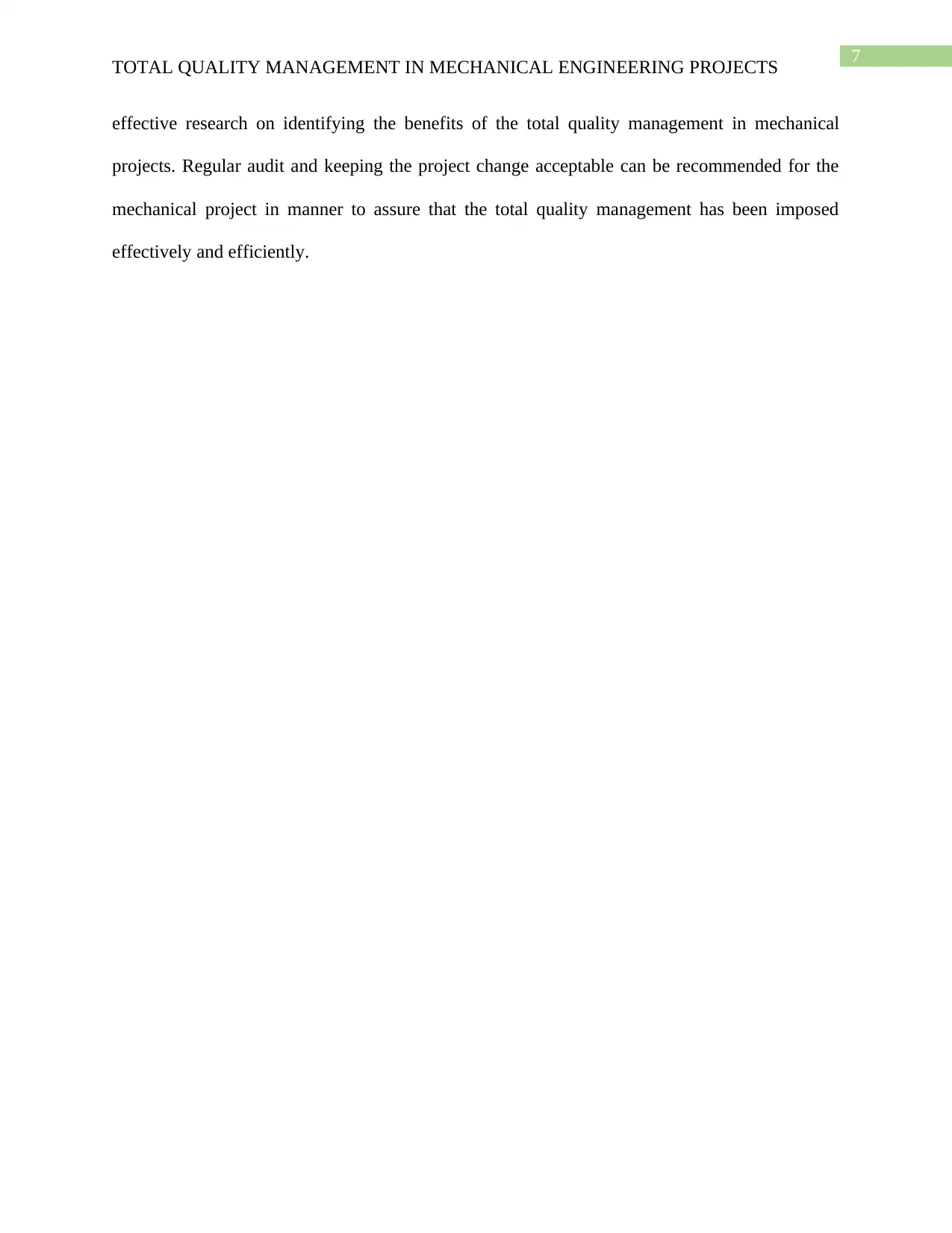
7
TOTAL QUALITY MANAGEMENT IN MECHANICAL ENGINEERING PROJECTS
effective research on identifying the benefits of the total quality management in mechanical
projects. Regular audit and keeping the project change acceptable can be recommended for the
mechanical project in manner to assure that the total quality management has been imposed
effectively and efficiently.
TOTAL QUALITY MANAGEMENT IN MECHANICAL ENGINEERING PROJECTS
effective research on identifying the benefits of the total quality management in mechanical
projects. Regular audit and keeping the project change acceptable can be recommended for the
mechanical project in manner to assure that the total quality management has been imposed
effectively and efficiently.
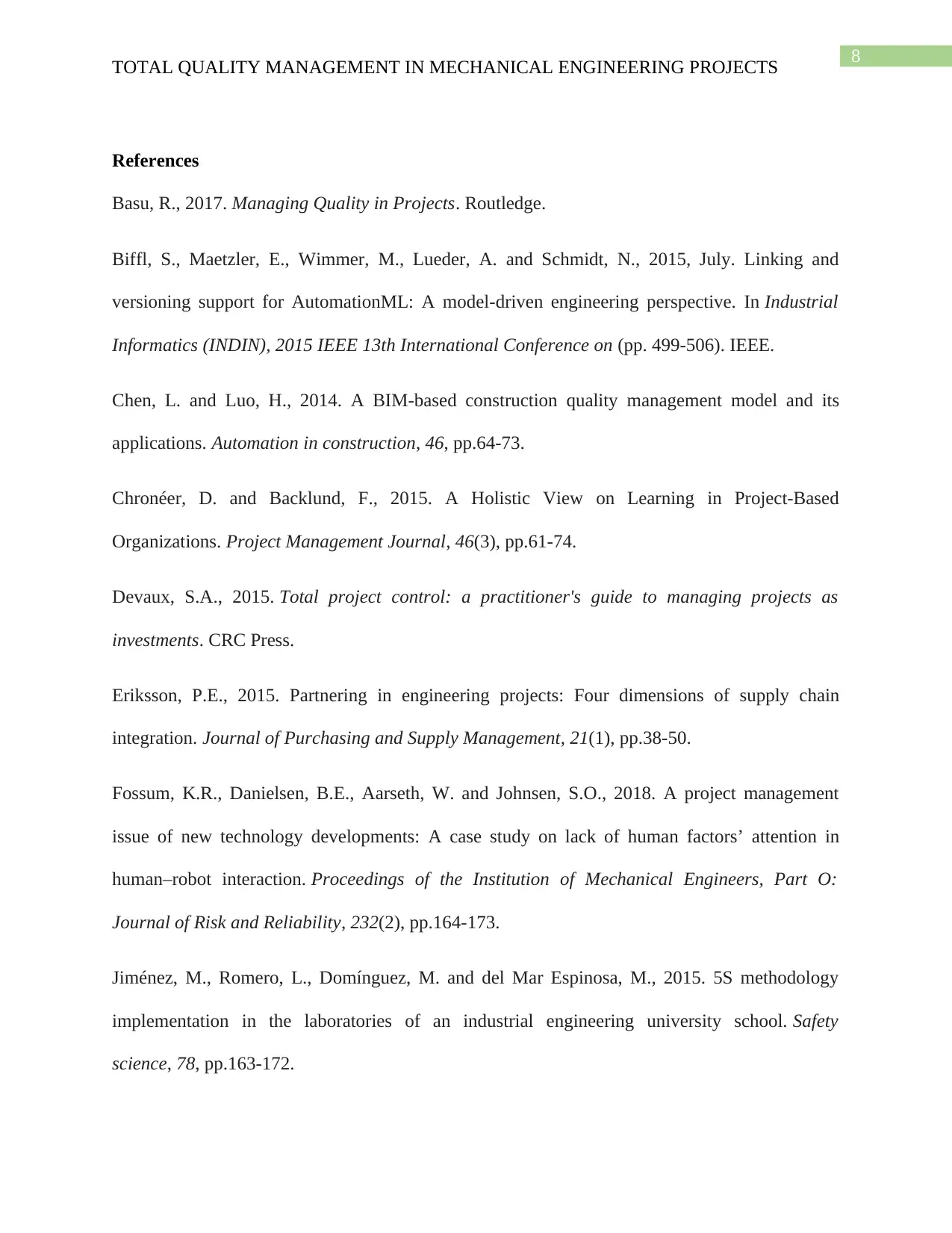
8
TOTAL QUALITY MANAGEMENT IN MECHANICAL ENGINEERING PROJECTS
References
Basu, R., 2017. Managing Quality in Projects. Routledge.
Biffl, S., Maetzler, E., Wimmer, M., Lueder, A. and Schmidt, N., 2015, July. Linking and
versioning support for AutomationML: A model-driven engineering perspective. In Industrial
Informatics (INDIN), 2015 IEEE 13th International Conference on (pp. 499-506). IEEE.
Chen, L. and Luo, H., 2014. A BIM-based construction quality management model and its
applications. Automation in construction, 46, pp.64-73.
Chronéer, D. and Backlund, F., 2015. A Holistic View on Learning in Project‐Based
Organizations. Project Management Journal, 46(3), pp.61-74.
Devaux, S.A., 2015. Total project control: a practitioner's guide to managing projects as
investments. CRC Press.
Eriksson, P.E., 2015. Partnering in engineering projects: Four dimensions of supply chain
integration. Journal of Purchasing and Supply Management, 21(1), pp.38-50.
Fossum, K.R., Danielsen, B.E., Aarseth, W. and Johnsen, S.O., 2018. A project management
issue of new technology developments: A case study on lack of human factors’ attention in
human–robot interaction. Proceedings of the Institution of Mechanical Engineers, Part O:
Journal of Risk and Reliability, 232(2), pp.164-173.
Jiménez, M., Romero, L., Domínguez, M. and del Mar Espinosa, M., 2015. 5S methodology
implementation in the laboratories of an industrial engineering university school. Safety
science, 78, pp.163-172.
TOTAL QUALITY MANAGEMENT IN MECHANICAL ENGINEERING PROJECTS
References
Basu, R., 2017. Managing Quality in Projects. Routledge.
Biffl, S., Maetzler, E., Wimmer, M., Lueder, A. and Schmidt, N., 2015, July. Linking and
versioning support for AutomationML: A model-driven engineering perspective. In Industrial
Informatics (INDIN), 2015 IEEE 13th International Conference on (pp. 499-506). IEEE.
Chen, L. and Luo, H., 2014. A BIM-based construction quality management model and its
applications. Automation in construction, 46, pp.64-73.
Chronéer, D. and Backlund, F., 2015. A Holistic View on Learning in Project‐Based
Organizations. Project Management Journal, 46(3), pp.61-74.
Devaux, S.A., 2015. Total project control: a practitioner's guide to managing projects as
investments. CRC Press.
Eriksson, P.E., 2015. Partnering in engineering projects: Four dimensions of supply chain
integration. Journal of Purchasing and Supply Management, 21(1), pp.38-50.
Fossum, K.R., Danielsen, B.E., Aarseth, W. and Johnsen, S.O., 2018. A project management
issue of new technology developments: A case study on lack of human factors’ attention in
human–robot interaction. Proceedings of the Institution of Mechanical Engineers, Part O:
Journal of Risk and Reliability, 232(2), pp.164-173.
Jiménez, M., Romero, L., Domínguez, M. and del Mar Espinosa, M., 2015. 5S methodology
implementation in the laboratories of an industrial engineering university school. Safety
science, 78, pp.163-172.
⊘ This is a preview!⊘
Do you want full access?
Subscribe today to unlock all pages.

Trusted by 1+ million students worldwide
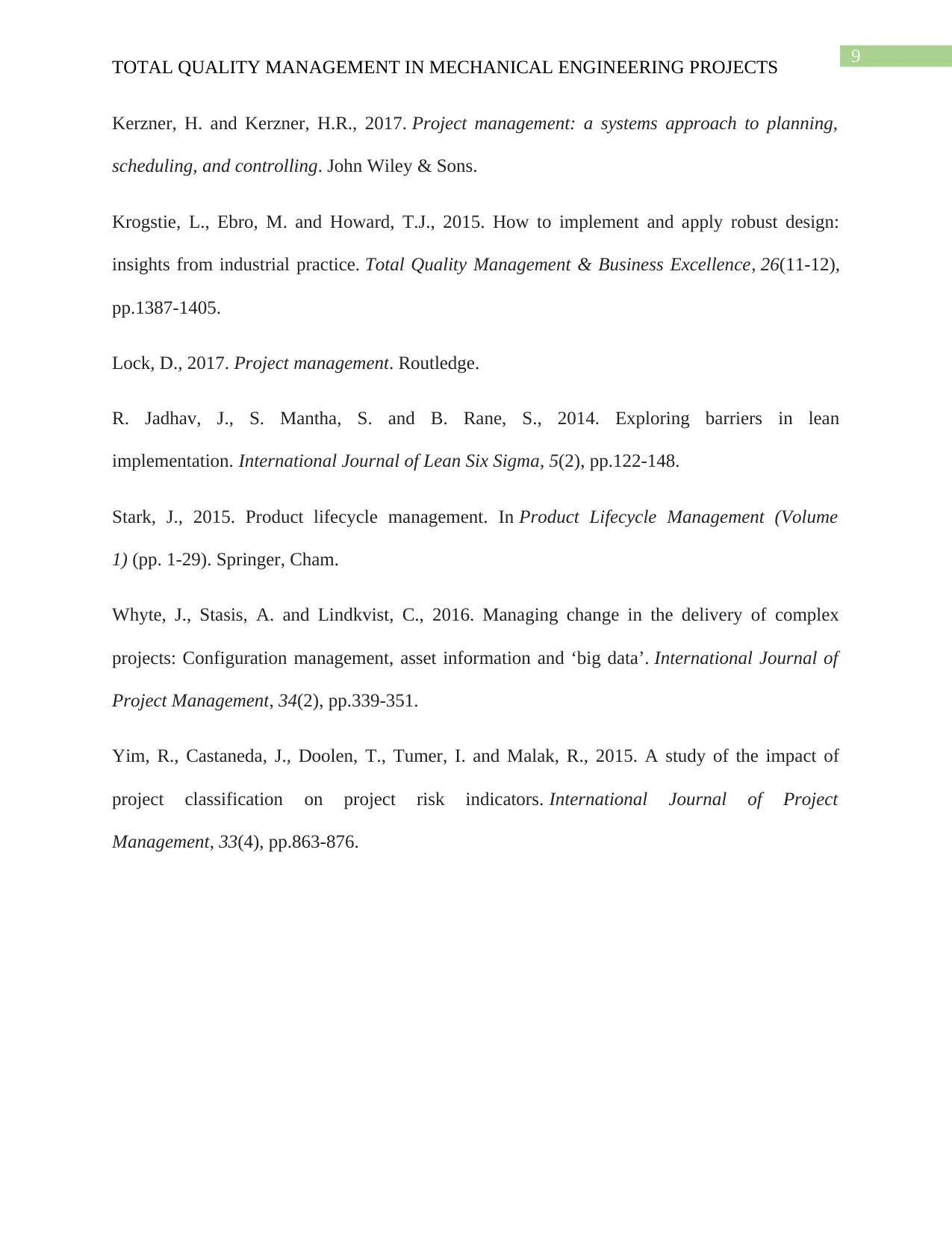
9
TOTAL QUALITY MANAGEMENT IN MECHANICAL ENGINEERING PROJECTS
Kerzner, H. and Kerzner, H.R., 2017. Project management: a systems approach to planning,
scheduling, and controlling. John Wiley & Sons.
Krogstie, L., Ebro, M. and Howard, T.J., 2015. How to implement and apply robust design:
insights from industrial practice. Total Quality Management & Business Excellence, 26(11-12),
pp.1387-1405.
Lock, D., 2017. Project management. Routledge.
R. Jadhav, J., S. Mantha, S. and B. Rane, S., 2014. Exploring barriers in lean
implementation. International Journal of Lean Six Sigma, 5(2), pp.122-148.
Stark, J., 2015. Product lifecycle management. In Product Lifecycle Management (Volume
1) (pp. 1-29). Springer, Cham.
Whyte, J., Stasis, A. and Lindkvist, C., 2016. Managing change in the delivery of complex
projects: Configuration management, asset information and ‘big data’. International Journal of
Project Management, 34(2), pp.339-351.
Yim, R., Castaneda, J., Doolen, T., Tumer, I. and Malak, R., 2015. A study of the impact of
project classification on project risk indicators. International Journal of Project
Management, 33(4), pp.863-876.
TOTAL QUALITY MANAGEMENT IN MECHANICAL ENGINEERING PROJECTS
Kerzner, H. and Kerzner, H.R., 2017. Project management: a systems approach to planning,
scheduling, and controlling. John Wiley & Sons.
Krogstie, L., Ebro, M. and Howard, T.J., 2015. How to implement and apply robust design:
insights from industrial practice. Total Quality Management & Business Excellence, 26(11-12),
pp.1387-1405.
Lock, D., 2017. Project management. Routledge.
R. Jadhav, J., S. Mantha, S. and B. Rane, S., 2014. Exploring barriers in lean
implementation. International Journal of Lean Six Sigma, 5(2), pp.122-148.
Stark, J., 2015. Product lifecycle management. In Product Lifecycle Management (Volume
1) (pp. 1-29). Springer, Cham.
Whyte, J., Stasis, A. and Lindkvist, C., 2016. Managing change in the delivery of complex
projects: Configuration management, asset information and ‘big data’. International Journal of
Project Management, 34(2), pp.339-351.
Yim, R., Castaneda, J., Doolen, T., Tumer, I. and Malak, R., 2015. A study of the impact of
project classification on project risk indicators. International Journal of Project
Management, 33(4), pp.863-876.
1 out of 10
Related Documents
Your All-in-One AI-Powered Toolkit for Academic Success.
+13062052269
info@desklib.com
Available 24*7 on WhatsApp / Email
![[object Object]](/_next/static/media/star-bottom.7253800d.svg)
Unlock your academic potential
Copyright © 2020–2025 A2Z Services. All Rights Reserved. Developed and managed by ZUCOL.

